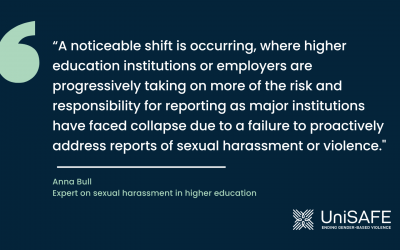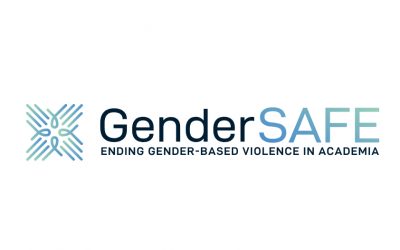In this new report UniSAFE provides a synthetic analysis of the different strands of evidence collected within the project until now. It relies on a multi-level study of the knowledge created within the project on the prevalence, determinants and consequences of gender-based violence in research performing organisations (RPOs), particularly within the remit of the 7P model.
Findings are divided into three parts:
- a descriptive analysis of the survey sample, including prevalence and consequences of gender-based violence;
- an intersectional quantitative analysis of the prevalence and consequences of gender-based violence;
- and a quantitative analysis of the effects of national and organisational characteristics.
In all three parts, the results of the quantitative analysis are supplemented by insights gained through the qualitative work undertaken through in-depth interviews and case studies of institutional measures.
Descriptive analysis of survey sample
The results first provide a descriptive analysis of the demographic and functional characteristics of the survey respondents, followed by the prevalence and consequences of gender-based violence within these groups, and how much this varies in the context of the different RPOs and countries in which the fieldwork was conducted. Findings suggests that the prevalence of gender-based violence is relatively uniform across countries. Similarly, variance is low between RPOs which suggests that the prevalence of gender-based violence is largely unrelated to the RPOs in which respondents work or study, and/or to the country in which they reside.
Further, findings suggest that prevalence is relatively uniform across most intersectional groups, though a few disclose more experiences of gender-based violence. Adverse outcomes are consistently higher among people that have experienced any form of gender-based violence, and can therefore be regarded as consequences of gender-based violence. This is most marked for social exclusion, which 70% of those having experienced gender-based violence report. These adverse outcomes are relatively uniform across countries and RPOs in both form and magnitude.
Intersectional analysis of prevalence and consequences of gender-based violence
The report analyses the prevalence and consequences of gender-based violence among different groups, also considering intersecting factors such as terms of employment, ethnicity, sexual orientation etc. The analysis is based on multi-level intersectional modelling that controls for a range of factors, including the time spent the institution where respondents study or work.
Prevalence of gender-based violence
Position within the institution
Findings show that when controlling for these other variables, students are less affected by gender-based violence overall, but more at risk of physical and sexual than staff members. Staff and students are however almost equally affected by online violence.
Experiences of gender-based violence are not only related to student and staff status but also to the terms of one’s employment/position. Some doctoral candidates, early-career researchers and researchers and teaching staff who sought promotion to a higher position were, for instance, identified as particularly vulnerable to gender-based violence in the qualitative interviews.
Gender identity and sexual orientation
Findings on gender identity are that:
- respondents identifying as women are most at risk of sexual violence and sexual harassment;
- respondents identifying as men are most at risk of physical violence;
- respondents identifying as non-binary people are most at risk of sexual harassment, psychological violence and economic violence;
- trans people are more subjected to psychological violence and sexual harassment.
Groups of respondents who belong to a minoritised sexual orientation group had a higher prevalence of overall gender-based violence compared to heterosexual respondents, controlling for other factors.
Other intersectional factors
When controlling for these other factors, all forms of gender-based violence are more prevalent across people with a disability or chronic illness. People from a minority ethnic group also have higher prevalence of all forms of gender-based violence. While staff and students that were international (i.e. people who have moved from the country where they have obtained their highest level of qualification to study or work in another country), rather than domestic, were overall as likely to experience gender-based violence. The only exceptions are economic violence and sexual violence. Thus, being an international staff/student is associated with higher risk of economic violence and sexual violence. Increasing age is associated with lower prevalence of most forms of gender-based violence. Each additional year of age decreased the overall prevalence of gender-based violence. Exceptions were economic violence, which increased with age and online violence which is unrelated to age.
Consequences of gender-based violence
Most forms of gender-based violence are associated with worse outcomes when it comes to potential consequences of gender-based violence, when controlling for other factors. Disclosing any form of gender-based violence in the survey is systematically associated with feeling less safe, feeling unwell and lower work productivity or study performance. All forms of gender-based violence measured, except for sexual violence, are associated with higher feelings of social exclusion and detrimental consequences for work. Finally, all forms of gender-based violence measured, except physical violence, are associated with detrimental consequences for studies.
Students are less at risk of social exclusion, but more at risk of feeling unsafe and feeling unwell, while controlling for other factors, and this is exacerbated by experiences of gender-based violence. Women and non-binary people were also more likely to feel social excluded and unsafe. In the qualitative interviews, more than one third of the interviewees described that social exclusion of victims would manifest in a form of treating victims as difficult, crazy, mad or paranoid, and with whom it is difficult to work.
Trans people were more likely to feel unsafe and to feel unwell, but suffered fewer consequences for work. Bisexual, homosexual and queer people are more likely to feel unsafe, to feel unwell and to experience detrimental consequences for studies. All minoritised sexual orientation measured, with the exception of people who are asexual, report higher consequences, including feeling unsafe and feeling unwell. They also were more likely to experience detrimental consequences for studies, though this is not the case for work except for homosexual respondents. Feeling socially excluded appears unrelated to sexual orientation.
Having a disability or chronic illness increased reports of feeling socially excluded, unsafe and unwell, as well as experiences detrimental for work or studies, when controlling for other factors. Being from a minority ethnic background was linked to higher feelings of being unsafe and consequences for studies. Respondents from a minority ethnic background did not feel more socially excluded nor unwell, though they were more likely to feel unsafe. They were not more likely to experience work-related consequences, though they were more likely to report study-related consequences. Being an international staff/student was unrelated to most consequences, and they were not more likely than domestic staff/students to report any consequences.
Finally, when controlling for other factors, the consequences of gender-based violence are lower for non-academic staff than academic staff across all forms, including feeling socially excluded. Permanent staff were more likely to feel unsafe than those of fixed-term contracts and staff working full-time hours were more likely to feel unwell. Postgraduate students were less likely than undergraduate students to report consequences for studies but more likely to feel socially excluded.
Analysis of national and organisational characteristics
The results provide an analysis of the relationship between the prevalence and consequences of gender-based violence, overall and in relation to specific forms (physical violence, psychological violence, economic violence, sexual violence, sexual harassment and online violence), in relation to selected national and organisational characteristics.
The analysis suggests that many of the national/organisational characteristics related to higher prevalence tend to be related to mechanisms that make gender-based violence more visible (e.g. via policies that put into place measurement, monitoring and evaluation), less acceptable (e.g. via policies that make perpetrator accountable through prosecution mechanisms). On the contrary, characteristics related to lower prevalence tend to focus on prevention and provision of services. It is important to remember that it is not possible to establish a causal effect, for example to conclude that the introduction of a national or organisational policy decreases the prevalence of gender-based violence. The question of directionality also matters. This analysis cannot differentiate between scenarios where the introduction of a policy has successfully decreased prevalence (negative association), or where a policy has been introduced in response to a high prevalence (positive association). Equally, it is not possible to identify when a policy has successfully increased capacity for victims to disclose and report experiences of gender-based violence. Interpretation is fundamental when it comes to analysing the prevalence of gender-based violence. Lower prevalence is not necessarily a desirable outcome, nor does it necessarily reflect reality. For this reason, looking at the prevalence of gender-based violence alone is insufficient. Instead, we look at prevalence together with the potential consequences that gender-based violence can have and how it can be associated with feeling excluded, feeling unsafe and feeling unwell, as well as to consequences experienced in relation to work or studies.
Prevalence measures disclosed incidents of gender-based violence, however, the actual prevalence rate remains unknown. On the one hand, self-selection bias might artificially inflate prevalence: this is the case for example if people that have experienced gender-based violence are more prone to respond to the survey. However, studies of sexual violence on campus have shown near identical levels of reporting using self-selection and human subject pool sampling (Rosenthal & Freyd, 2018) and in studies of violence against women and men, the only evidence of non-response bias found was for differences between the sample and the background population concerning the sociodemographic characteristics (Simmons & Swahnberg, 2019). On the other hand, respondents may not disclose experiences of gender-based violence. In practice, there are many reasons why disclosure does not happen. This includes low awareness that experiences of violence were in fact violence, and is related to the normalisation of violence, and social desirability response bias, which is related to underreporting in surveys (van de Mortel, 2008). The UniSAFE survey asks about specific incidents rather than relying on labels (e.g. not using the word ‘rape’ but incidents that may constitute rape such as ‘whether someone was forced into sexual intercourse by being held down or hurt in some way’). Nonetheless, not understanding nor framing an incident as violence may limit recollection and, thereafter, disclosure. Finally, many experiences of gender-based violence remain undisclosed because of the stigma attached to them, fear of victimisation and indeed re-victimisation, and low confidence that people and institutions can provide a resolution. Where that is the case, prevalence might be low despite a high number of incidents. In these cases, higher (disclosed) prevalence can thus be regarded as a positive outcome.



